Prime Ministers
Forging the Nation - Federation: the First 20 years
- Forging the Nation: home
- Federation
- National identity
- Seeking security
- The First World War
- Towards the future
- Australians
- Introduction
- Commonwealth celebrations
- Governors-General
- Prime Ministers
There were seven Prime Ministers during the nation's first two decades. Each had previously served in state parliaments and had played a role in the achievement of federation, though not all of them had given it consistent support. Edmund Barton, Australia's first Prime Minister (1901-3), was a champion for federation and leader of the Protectionist Party. John Watson became the first Labor Prime Minister in the world in 1904: he was expelled from the party in 1916 for supporting conscription. Alfred Deakin was a gifted and complex man and Prime Minister three times. He had been Barton's deputy, was a firm supporter of federation and initiated much progressive social legislation. Andrew Fisher, a wise and modest leader, was also Prime Minister three times and introduced many significant new policies. George Reid, once called "Yes - No Reid" because of his wavering support for federation, held the job for only one year. Joseph Cook was Prime Minister at the outbreak of the First World War and pledged his country's support to Britain, but was quickly succeeded, briefly by Fisher, then by William Morris Hughes. The fiery and unscrupulous Hughes became the dominant political figure of the time.

Twenty years after: a study in perspective, from The Bulletin 19 May 1919, pg 10. Collection of the Australian War Memorial.

John Frith
Billy Hughes
terracotta
made in Melbourne 1981
Prime Minister William Morris (Billy) Hughes was a founder of the Australian Labor Party and became Prime Minister in 1915. He was small, active and pugnacious, and his determination to introduce conscription split the party. He left Labor but remained in office with the support of the Opposition, which he led from 1917 as the Nationalist Party. He strongly represented Australia's views at the Peace Conference at Versailles in 1919. He remained Prime Minister until 1923.
